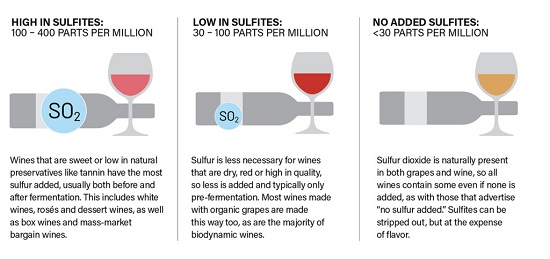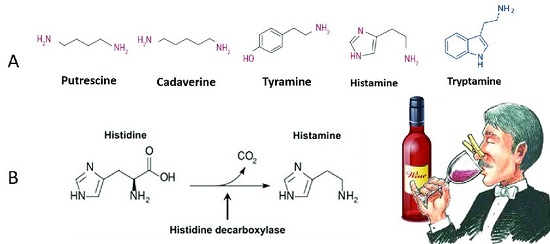Educating Sommeliers Worldwide.
By Beverage Trade Network

Many people are concerned about experiencing headaches after drinking wine, and they typically attribute this to the presence of sulfites in the wine. Sulfites have been treated like the redheaded stepchild of wine, even though they are an integral element of wine chemistry. Without sulfites, the shelf life of wines will reduce, and most wines would spoil due to bacteria.
[[relatedPurchasesItems-32]]
Sulphites or Sulfites are a class of sulfur-based mineral compounds that have been used for centuries as an antioxidant, antibacterial agent, and preservative in food and beverages like wine. They are also found naturally in some foods and are the most abundant mineral found in the body after calcium and phosphorus.
Sulfur dioxide has been added to wine by winemakers since the 1800s. To improve winemaking cleanliness, almost all vintners, including most organic practitioners, add a little sulfur dioxide to grapes before fermentation. Since at least the days of Ancient Greece, when flame cleansing of fermenting vessels was used, this has been a critical winemaking method.
It remains thus to this day because wine is severely destabilized without sulfur at this stage, allowing microbial activity and oxidation to limit its shelf life. Pre-fermentation sulfur addition does raise the ultimate sulfur level of wine, but only a little because the majority settles off as sediment.
Sulfites are added to wine mainly for the following reasons:
- The addition of sulfites in wine aids in the prevention of the growth of unwanted microorganisms in wine.
- Sulfites prevent wine from oxidizing. Preserves desired aromas and color of the wine.
- Sulfites protect wine from yeast-laden invasions.
- Wines with lower acidity require more sulfites than wines with higher acidity. Wines are much less stable at pH 3.6 and above, and sulfites are needed for shelf-life.
- Wines with more color (for example, red wines) require fewer sulfites than clear wines (i.e., white wines). A typical dry white wine may contain 100 mg/L, whereas a dry red wine may contain 50–75 mg/L.
- Warmer wines release free sulfur compounds (the unpleasant sulfur odor) and can be "fixed" by decanting and chilling the wine.
- Wines with high sugar content require more sulfites to prevent secondary fermentation of the residual sugar.

Image Source: Beverage Dynamics
Sulfite is a natural by-product of fermentation, so making a sulfite-free wine is impossible. Since 1987, wine labels in the United States have been obliged to state if wines contain sulfite amount of 10 parts per million or more, a policy designed to protect the small percentage of the population—roughly one in every hundred people—who are allergic to sulfite. On the other hand, scientists have discovered no link between sulfites in wine and headaches. The typical reaction to this allergy is hives and difficulties breathing, rather than a headache. Furthermore, white wines have more sulfites added to them than red wines.

Image Source: Just Wine, Pay Attention to what you are consuming.
Tannins are plant compounds found in grape skins that contribute to the flavor of a wine. Tannins also trigger a response in the body to release serotonin, which in some people can induce headaches. Tannins are present in various foods, including tea, dark chocolate, berries, and nuts. They are more abundant in red wines than in white wines.
If you notice headaches more frequently when you drink red wine, such as Cabernet Sauvignon or Malbec, you can perform a short test to discover if tannins are to blame. Black tea contains a lot of tannins.
- Make a cup of black tea and steep it for five to ten minutes.
- Take a sip of the tea and see if it gives you a headache. If you are, you are sensitive to tannins, and avoiding red wines will help you avoid headaches.
Phenolic Flavonoids are compounds like tannins present in the skin and stem of grapes. The flavonoid phenolic compounds are most likely to cause your brain to release serotonin or produce different enzymatic reactions in your gut and are blamed for red wine-induced headaches in both migraineurs and non-migraineurs. Natural phenols and polyphenols contribute to the taste and texture of the wine. These compounds also give the wine its mouthfeel and color.
Biogenic amines are a class of chemicals produced during fermentation that include headache-causing substances like Histamine and Tyramine. While amine level in wine varies widely, reds have a higher amine content than whites. Histamine is a chemical found in grape skins. Because white wine is created without the grape's skin, it has less histamine than red wine, which is made from the whole grape. Simply take a histamine blocker before drinking a glass of red wine to avoid a histamine headache.
On the other hand, Tyramine is an amino acid found in wine and cheese that occurs spontaneously during fermentation. Given that it is a natural by-product, it can be challenging for people's bodies to break it down. Due to the double dose of tyramine, a wine and cheese combination can frequently result in a hangover the next morning. It's best to avoid wine and cheese nights.

Image Source: Research Gate
Sugar content, The combination of alcohol and sugar is a leading cause of wine headaches, as both require a large amount of water to process properly. If you aren't adequately hydrated, your body will begin to draw water from other parts of your body, including your brain. A headache develops as the fluids in your head start to decrease. To avoid this condition, stay away from sweet dessert wines and semi-dry or sweet white wines like Riesling (if you enjoy Riesling, make sure the wine is labeled as dry). Cheaper wines should also be avoided, as they tend to have more sugar due to mass producers adding sugar during fermentation to raise the alcohol content.
The best way to prevent a headache from wine is to take precautions. Try these simple hacks the next time you open a bottle of wine to avoid that awful headache after drinking wine.
To avoid a wine headache, drink a glass of water for every glass of wine you consume.
Select wines with low tannins and tyramine levels.
Drinking wine on an empty stomach is not recommended.
Take allergy medication before drinking wine to avoid a wine headache.
Article By Aakriti Rawat, Beverage Trade Network
Header Image Source: Mylocal Vineyard Wine Headaches